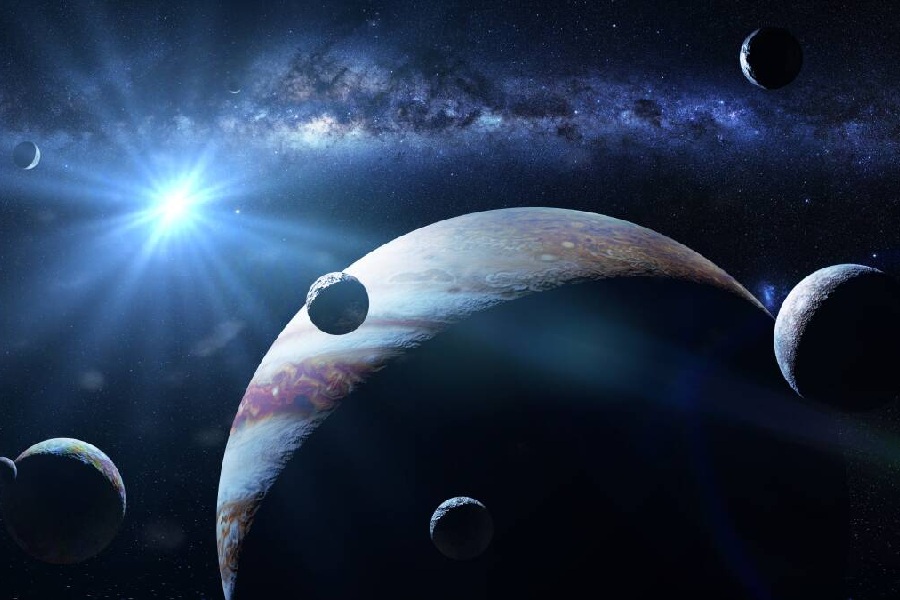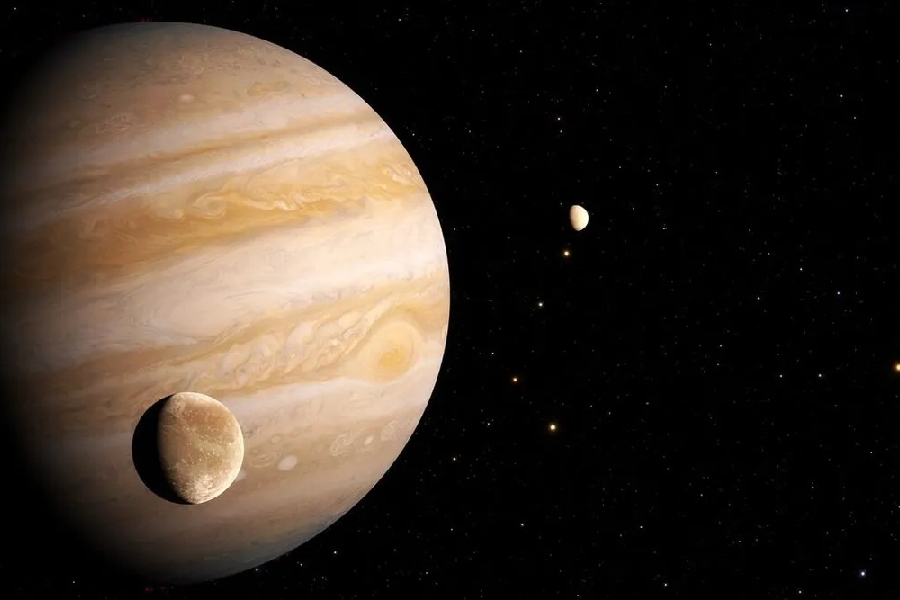The largest moon in our Solar System hosts some surprisingly Earthlike traits under its icy exterior. Jupiter’s giant satellite, Ganymede, appears an unlikely oasis at first. Yet theorized underground oceans and polar auroras evoke visions of a potentially living alien aqua world within this frozen orb. But is Ganymede habitable?
This article peers beneath the frigid surface of Ganymede to investigate its potential for habitability. We will traverse spectacular icy terrains and liquid ocean depths.
We will also explore whether Ganymede has a protective magnetic field bubble. In addition, we will analyze how Jupiter’s intense radiation, which bombards Ganymede in its orbit, impacts prospects for life developing within this icy moon.
Join us on an adventure touring the Solar System’s largest moon as we unravel one of space science’s most exhilarating mysteries.

Is Ganymede Habitable?
Ganymede, Jupiter’s largest moon, might not be suitable for human habitation. Despite having a thin atmosphere primarily composed of oxygen, it’s insufficient for breathing. The moon’s surface, covered in ice and lacking liquid water essential for life, further adds to its inhospitality.
Additionally, Ganymede faces relentless bombardment from harmful radiation due to Jupiter’s intense magnetic field, making it unsuitable for life as we know it. While Ganymede may boast intriguing features, humans couldn’t inhabit it without substantial technological support.
Potential habitability
Ganymede may have a saltwater ocean deep below its icy surface, which could support life. However, studying whether life-supporting conditions exist on this moon is challenging, driving at the core question – can Ganymede support life?
The surface is extremely cold, making accessing that energy a major challenge. The hypothesized subsurface ocean may interact with the rocky core, possibly providing nutrients to support ecosystems. Yet, the ocean itself is difficult to access underneath the thick ice.
Ganymede’s Characteristics
Ganymede, the largest moon in our Solar System, surpasses the sizes of both Mercury and Pluto with a diameter of 5,268 km (3,270 mi). Composed of rock and ice, it sports a substantial outer layer of ice, possibly concealing an ocean beneath. Its surface showcases a variety of geological features, including craters, valleys, and mountains.
Distinct regions on Ganymede display varying ages, with some areas being ancient and others younger, featuring fewer craters. Cracked sections of ice are scattered across parts of its surface. Like Earth, Ganymede boasts an iron core, albeit smaller than Earth’s, while still exceeding the size of our Moon.
In contrast to Earth’s dense gaseous envelope, Ganymede possesses a thin atmosphere. Its gravity is notably weaker than Earth’s, and despite having a liquid iron core like Earth, Ganymede’s core is smaller.
Nevertheless, it generates a magnetic field akin to Earth’s metallic core, offering protection from solar radiation. This magnetic shield contributes to Ganymede’s potential habitability by providing crucial protection.
Surface conditions
Ganymede boasts an outer ice layer that could be as thick as 800 km (497 miles), with a frigid surface temperature of -163 °C (-261.4 °F). Over time, this icy shell has developed cracks from shifting. There might be liquid oceans about 100-150 km (62-93 mi) beneath the surface.
These liquid water oceans hold the potential to support life. Surface grooves and cracks reveal the movement of icy layers, indicating the presence of slushy thawed regions underneath. Magnetic readings also suggest the likelihood of salty liquid pointing towards subsurface oceans.
To confirm the existence and characteristics of these oceans, more observations are needed. The presence of liquid water could create habitats for sustaining life, given the essential elements of water and energy and nutrient sources.

Atmospheric conditions
Ganymede’s atmosphere is thin, with small amounts of gases such as oxygen and hydrogen. Unlike Earth’s dense atmosphere, the gases surrounding Ganymede exert a minor force.
The atmosphere includes oxygen, hydrogen, and possibly carbon dioxide and sulfur but remains tenuous. Estimates suggest a density ranging from 20 trillion to 2 quadrillion molecules per cubic centimeter.
Due to its sparse nature, Ganymede’s atmosphere struggles to retain heat and warm the frigid surface, which stays extremely cold. However, it does play a role in distributing some warmth internally. Additionally, the thin atmosphere provides minor protection against solar and cosmic radiation.
Radiation environment
Ganymede, orbiting close to Jupiter, experiences intense radiation from Jupiter’s powerful magnetosphere. The radiation levels surpass even those of the solar wind, threatening Ganymede’s surface ice over time.
The extreme radiation on the surface makes it inhospitable for known forms of life. Despite this, the ice and potential subsurface oceans offer some shielding possibilities for potential organisms. However, radiation still presents significant challenges to habitability.
The thick ice crust and hypothesized oceans could partially shield against radiation, with Ganymede’s weak magnetic field providing minor protection. However, radiation bombardment remains a persistent concern.
If life were to develop in subsurface oceans, the penetrating radiation at such depths could damage cells and DNA, making survival challenging. Organisms would likely need adaptations to cope with radiation or be confined to the deepest underwater layers.
Challenges and Limitations
Ganymede, orbiting close to Jupiter, experiences intense radiation from Jupiter’s powerful magnetosphere. The radiation levels surpass even those of the solar wind, threatening Ganymede’s surface ice over time.
The extreme radiation on the surface makes it inhospitable for known forms of life. Despite this, the ice and potential subsurface oceans offer some shielding possibilities for potential organisms. However, radiation still presents significant challenges to habitability.
The thick ice crust and hypothesized oceans could partially shield against radiation, with Ganymede’s weak magnetic field providing minor protection. Nevertheless, radiation bombardment remains a persistent concern.
If life were to develop in subsurface oceans, the penetrating radiation at such depths could damage cells and DNA, making survival challenging. Organisms would likely need adaptations to cope with radiation or be confined to the deepest underwater layers.
Conclusion
As we conclude our quest exploring Ganymede’s habitability, we find this icy ocean world encapsulates many profound questions on life’s evolution and potential survival in realms beyond Earth. So, is Ganymede hospitable?
Our analysis concludes that major questions remain about how habitable Ganymede could be. Many mysteries are yet to be uncovered regarding the environment deep inside this icy moon.
Future space missions could help reveal more by sampling Ganymede’s subsurface material. This may provide insights into two key issues: does the ocean contain life’s ingredients? And if so, could organisms actually survive there?
Missions could reveal whether Ganymede’s global subsurface ocean has the basic ingredients and energy required for hosting life. Studying one of the Solar System’s largest potentially habitable marine environments should inspire further exploration into hidden aqua worlds beyond Earth.
